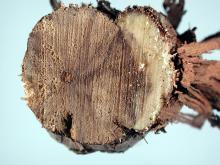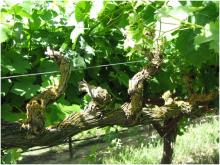By M. Putnam
See:
Grape (Vitis spp.) - Eutypa Dieback
Cause Members of the Botryosphaeriaceae, including multiple species of the fungus Botryosphaeria, are known to cause a range of symptoms, which have also been referred to as "Bot canker." These fungi cause perennial cankers and enter vines through fresh injuries such as natural cracks, pruning wounds, or any large cut to cordons or trunks. Spores are released from pycnidia on diseased vines during rain events (or overhead irrigation) in the dormant season from November to February in Oregon. Spores can germinate in a fresh wound when temperatures are above 5°C (41°F). Fresh wounds are more susceptible to spore infection than older cuts. Pruning wounds made early in the dormant period are much more susceptible than wounds made late in the dormant period. These fungi become established in the vine at a wound site, growing toward the roots. Although water stressed vines are more susceptible to infection, subsequent colonization of the vine is more limited. Symptoms are generally not noticed until year 8 when disease incidence is about 10% but yield losses are to this point minor. Increasing losses occur from reduced vine productivity, poor yields and extra costs for cultural and chemical management.
Grapevine trunk diseases due to the Botryosphaeriaceae are prevalent in the Pacific Northwest. B. dothidea, B. corticola (=Diplodia corticola), B. quercuum, B. stevensii (= D. mutila), Lasiodiplodia, and Neofusicoccum parvum have all been recovered from vines in Oregon; and Neofusicoccum parvum and B. dothidea have been found in Okanagan vineyards in British Columbia. Disease due to the Botryosphariaceae is likely to have been overlooked, as symptoms are similar to those caused by Eutypa. Botryosphaeria dieback is more prevalent in high rainfall areas such as the Willamette Valley than in arid areas such as the Rogue Valley of Oregon.
Spread is thought to be by movement of spores from within an infected vineyard, rather than from sources outside of it. Spores, produced in pycnidia in infected vines and on prunings left behind, are spread by water splash up to 6-ft away. Use of infected cuttings can also spread the disease. Vines as young as five years old may be affected. Water stress will exacerbate the severity of symptoms.
Symptoms In cross section, older vines will show wedge-shaped cankers in the trunk and cordons, similar to those caused by Eutypa. On spur-pruned vines, infected spurs may not grow in the spring, or there may be growth followed by rapid wilt and collapse of the foliage. Some spurs may be dead, while others on the same cordon may produce apparently healthy foliage. In California, there are no foliar symptoms apparent on plants that have been infected by various species of Botryosphaeria. This is in contrast to Eutypa, which produces stunted spring growth and yellowed leaves. Young vines may show cankers, vascular discoloration, or dark streaking of the xylem. Drought can increase the severity of symptoms.
Cultural control Preventive tactics are more effective when started early in the life of a vineyard.
- In spring, when symptoms are evident, mark diseased vines for future removal.
- Prune hard well below the visible canker. Remove diseased wood 4 to 8 inches below discolored vascular tissue, and train a new, healthy shoot into position.
- If the canker is below ground, remove and replace the vine.
- Avoid large pruning cuts when possible; avoid pruning during and before wet weather. Pruning later in the dormant period has been useful in California but not British Columbia. Shoot thinning should also be done during dry weather.
- When making large cuts during wet weather, leave a stub several inches long to be pruned off later during dry weather. Sometimes referred to as delayed or double pruning or prepruning.
- Remove and destroy all large trunk, cordon or spur pieces from the vineyard. Annual pruning debris can also harbor these fungi and can be disposed of by burning, burying, or composting. Flailing prunings alone is not sufficient for removal of inoculum.
- Grow less susceptible cultivars such as Chardonnay.
- Supplemental irrigation may help manage symptom severity.
- Treating pruning wounds with sealants or paints has been effective when used within 24 hr of a pruning cut. These products include B-Lock, Spur Shield, or Vitiseal. See labels for details.
Chemical control Useful when pruning a new planting or retraining vines and making large trunk or cordon cuts. Tank mixes with products from different FRAC groups has also been helpful.
- Mettle 125 ME at 5 fl oz/25 to 50 gal water/A as a spray directed onto cuts within 24 hr of pruning. A second spray 2 weeks later is recommended. Do not use more than 10 oz/A/year for this and in-season powdery mildew treatments. Group 3 fungicide. 12-hr reentry.
- Rally 40 WSP at 5 oz/50 gal water as a spray directed onto cuts within 24 hr of pruning. A second spray 2 weeks later is recommended. Do not use more than 24 oz/A/year for this and in-season powdery mildew treatments. Group 3 fungicide. 24-hr reentry.
- Topsin 4.5 FL at 30 fl oz/A as a spray directed onto cuts within 24 hr of pruning. A second spray 2 weeks later is recommended. Topsin 4.5 FL may also be used at 4 fl oz/1 gal water and applied as a paint to cut or pruned surfaces. Use when rain is not expected after application. Group 1 fungicide. 2-day reentry.
- Topsin M WSB at 1.5 lb/50 gal water as a spray directed onto cuts within 24 hr of pruning. A second spray 2 weeks later is recommended. Topsin M WSB may also be used at 3.2 oz/1 gal water and applied as a paint to cut or pruned surfaces. Use when rain is not expected after application. Oregon only SLN OR-150009A. Group 1 fungicide. 2-day reentry.
Biological control Use in conjunction with cultural control tactics such as thorough sanitation. Trichoderma sp. have been shown to help protect pruning wounds, basal ends of propagation material, and graft unions before infection. Use within 24 hr of pruning and again in 2 weeks.
- Bio-Tam 2.0 (Trichoderma asperellum and T. gamsii) at 1 lb/A in 25 to 50 gal water plus a dye. May take a few weeks after application to be effective. (Was not effective when tested against Dothiorella iberica formerly Botryosphaeria iberica) 4-hr reentry. O
- Vintec (Trichoderma atroviride strain SC1) at 2.8 oz/A in 10 to 20 gal water. Apply shortly after pruning. Best efficacy occurs at temperatures above 50°F. 4-hr reentry. O
References Blundell, R. and Eskalen, A. 2022. Evaluation of biological and chemical pruning wound protectants to control grapevine trunk disease pathogens Eutypa lata and Neofusicoccum parvum. Plant Health Progress. 23:197-205. https://doi.org/10.1094/PHP-08-21-0113-RS
Hernandez, M. N. and Kc, A. N. 2023. A Systematic Survey on Prevalence of Grapevine Trunk Disease Pathogens in Oregon Vineyards. Plant Disease, 107:1355-1364.


